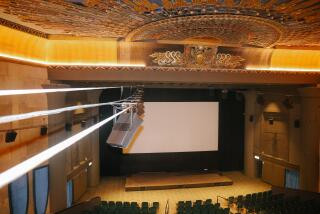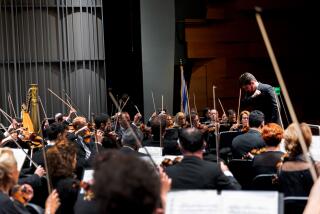Ernst Lubitsch’s ‘The Loves of Pharaoh’ is reborn
- Share via
The American Cinematheque’s Egyptian Theatre in Hollywood celebrates its 89th birthday Tuesday evening with a rare gift: the Los Angeles premiere of the recently restored version of Ernst Lubitsch’s 1922 German epic, “The Loves of Pharaoh.” Robert Israel will conduct a 16-piece orchestra playing the original score by renowned opera composer Eduard Künneke.
The guest of honor at the screening will be Lubitsch’s daughter, Nicola, 73. “I have not seen it,” she said. “The thing that I am really interested in is that the music is the original score that Daddy commissioned. I always think of my father as extraordinarily musical — he played the piano every day. And I find all of his German works and much later films highly choreographed.”
“The Loves of Pharaoh” stars Emil Jannings as Amenes, a powerful Egyptian Pharaoh who to prevent war needs to marry Theonis (Dagny Servaes), the daughter of the Ethiopian king. But Amenes discovers that he has a rival for her affection, his advisor Ramphis (Harry Liedtke).
Lubitsch made “The Loves of Pharaoh” to show Hollywood that he could make epics. (The film opened in New York before it premiered in Berlin). Lubitsch’s plan worked, and “Pharaoh” was his last German feature. He came to Hollywood in 1923, where he became a top director. He is best known for sophisticated musicals such as 1929’s “The Love Parade” and his classic comedies, including 1939’s “Ninotchka” and 1940’s “The Shop Around the Corner.” He died in 1947 at age 55.
The complete version of “The Loves of Pharaoh” had been considered lost for years, although parts of the film had been found in various countries. When it came time to put the film back together, it was akin to working on a massive jigsaw puzzle. Thomas Bakels of Munich-based Alpha Omega GmbH, the company that did the digital 2001 and 2010 restorations on Fritz Lang’s 1927 “Metropolis,” spent five years on the digital restoration; the Munich Film Museum did the reconstruction.
Part of the footage came from a 35mm tinted nitrate print of the movie that the German Federal Archives had acquired in the 1970s from a film archive in Russia in a trade for original footage it had of Sergei Eisenstein’s 1925 masterwork, “Battleship Potemkin.”
“The Federal Archives here approached us in 2003 with two reels of ‘Pharaoh’ and said, ‘What can be done? It is not scannable, it is not printable and this is the last surviving element,’” recalled Bakels.
The Russian footage lasted only 55 minutes and was missing all the scenes dealing with love and emotion. This version revolved around massive combat sequences. “It was in horrible shape,” noted Bakels. “One of the biggest problems with ‘Pharaoh’ was the perforations [on the negative] were missing all over the place.”
Bakels extended the Russian version with footage from an Italian nitrate print of “Pharaoh” that the George Eastman House in Rochester, N.Y., had acquired in 1998. Though the Italian print had been “chopped into pieces,” it contained the missing love scenes. To this was added other footage, as well as the picture’s title cards, that had shown up unidentified in film cans during the Munich Film Museum’s restoration work on another movie.
“Pharaoh” is still missing 10 minutes from its original running time of about 1 hour, 50 minutes. “We know that about 90% of the scenes are there,” Bakels said.
Bakels hopes to have the film released on Blu-ray and DVD this year.
For more information on the screening, go to https://www.americancinematheque.com.
More to Read
The biggest entertainment stories
Get our big stories about Hollywood, film, television, music, arts, culture and more right in your inbox as soon as they publish.
You may occasionally receive promotional content from the Los Angeles Times.










